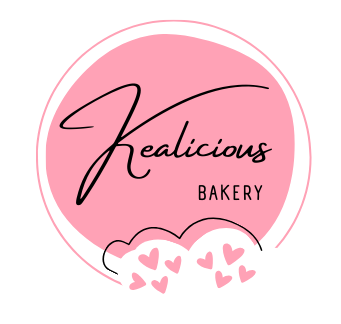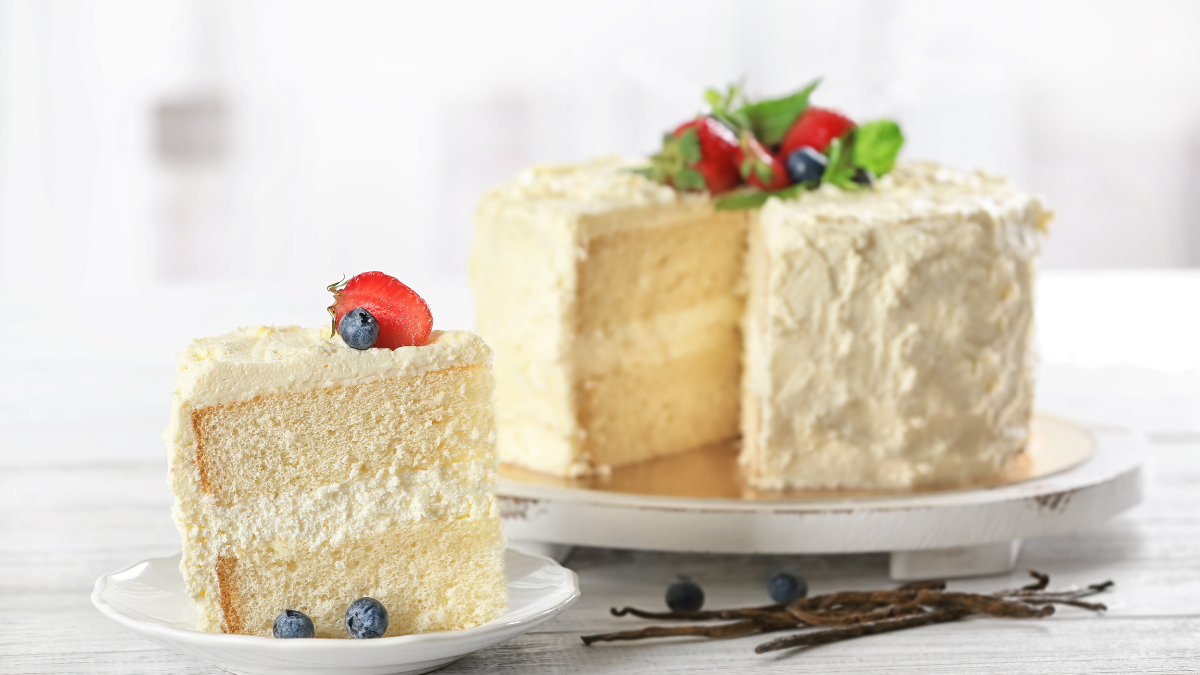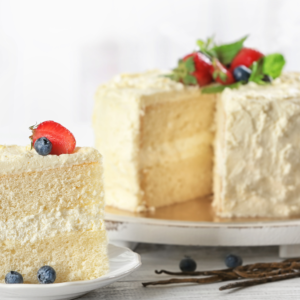In the world of baking, there’s a timeless delight that never fails to captivate our senses and evoke cherished memories—the Vanilla Cake. Beyond its simple appearance lies a canvas of pure indulgence, where the delicate aroma of vanilla and the tenderness of each crumb come together to create a symphony of flavor and texture.
The vanilla cake is a true classic, a versatile masterpiece that embodies both simplicity and elegance. From intimate family gatherings to grand celebrations, it stands as a symbol of comfort and festivity, beckoning us to savor life’s sweet moments.
Table of contents
- Ingredients
- Tips for baking
- How to make vanilla cake
- Decorating vanilla cake
- Assembling and decorating
- Troubleshooting and flavor variation
- Notes and tips
Ingredients
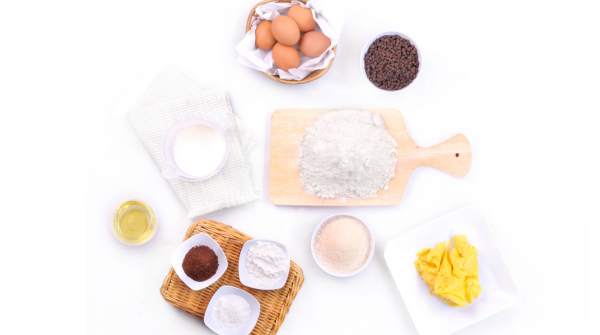
Eggs are essential in cake making as they provide structure, binding the ingredients together and contributing to the cake’s overall texture. They add moisture, ensuring a soft and moist crumb, while their proteins aid in emulsification, creating a smooth batter for even flavor distribution. Eggs act as natural leavening agents, helping the cake rise by trapping air and steam during baking. Additionally, they bring a delicate flavor and golden hue to the cake, enhancing its taste and visual appeal.
Cake flour‘s fine texture allows for better incorporation of liquids and fats, leading to a smoother batter and uniform mixing. The lower protein content reduces gluten development, ensuring the cake remains soft and not overly dense. Cake flour’s ability to absorb liquid efficiently results in a moist cake with a velvety mouthfeel. Its unique qualities make it a key ingredient for achieving the desired lightness and softness in cakes.
Butter is crucial because it contributes rich flavor and moisture to the cake, enhancing its taste and texture. Its fat content helps create a tender crumb by coating flour particles and inhibiting gluten formation, leading to a soft and delicate cake. Butter also aids in emulsification, resulting in a well-incorporated batter that ensures even distribution of flavors. Its ability to solidify at cooler temperatures adds structure and stability to the cake as it bakes.
Tips for baking
- Measure your ingredients accurately using measuring cups and spoons designed for dry and wet ingredients. Inaccurate measurements can affect the cake’s texture and rise.
- Ensure that ingredients like eggs, butter, and milk are at room temperature before beginning. Room temperature ingredients blend more smoothly and evenly into the batter.
- When creaming butter and sugar together, beat them until the mixture is light and fluffy. This incorporates air, which contributes to the cake’s rise and texture.
- Mix the batter according to the recipe instructions. Overmixing can lead to a dense cake, while undermixing can result in uneven textures.
- Grease and flour your cake pans or use parchment paper to prevent sticking. This ensures the cake comes out of the pan easily.
How to make vanilla cake
- Greasing your cake pan. Begin by using a small amount of butter or non-stick cooking spray. Using a paper towel or pastry brush, spread the butter evenly on the inside surfaces of the pan, including the sides. If using cooking spray, hold the can about 6-8 inches away from the pan and apply a thin, even coating. This prevents the cake from sticking to the pan during baking and allows for a smooth release once it’s done. Additionally, for extra insurance, consider lining the bottom of the pan with a parchment paper round before greasing to further facilitate easy removal.
- Preheat your oven to 355°F (180°C). This initial step ensures that your cake bakes evenly and at the correct temperature
- In a separate bowl, combine the dry ingredients for the cake: all-purpose flour, baking powder, and salt. Whisk these ingredients together thoroughly to ensure even distribution. Setting this mixture aside makes it ready for the next stage of the baking process.
- In another bowl, it’s time to work on the butter and sugar mixture. Use a handheld or stand electric mixer to cream the softened butter and granulated sugar together. The goal is to beat these ingredients until they transform into a pale and fluffy consistency. The incorporation of air during this process contributes to the cake’s texture and overall rise, adding lightness to the final product.
- With the butter and sugar creamed to perfection, introduce the eggs into the mixture, one at a time. After adding each egg, take the time to beat it well into the mixture until fully combined. Following the eggs, introduce a generous tablespoon of pure vanilla extract. This essence not only lends fragrance to the cake but also enhances its flavor profile.
- Now it’s time to merge the wet and dry ingredients. You could transfer your batter to your stand mixer. Then gradually introduce the dry flour mixture and milk to the butter and sugar mixture. To achieve a harmonious blend, start by adding a portion of the dry mixture, followed by a portion of milk, and repeat. Begin and end with the dry mixture, ensuring you maintain a steady but gentle mixing pace. This measured combination results in a cohesive batter without overmixing, which could lead to a dense cake.
- With the batter fully mixed, divide it evenly between the prepped cake pans. Use a spatula to distribute the batter, creating a smooth surface on top. Placing the pans in the preheated oven, allow them to bake for 25-30 minutes. Regularly check for doneness by inserting a toothpick into the center—the toothpick should come out clean or with a few moist crumbs when the cakes are fully baked.
- Once the cakes are baked to perfection, remove them from the oven and let them cool in the pans for approximately 10 minutes. This brief cooling period makes removing the cakes easier. Gently turn the pans upside down and tap to release the cakes. Transfer the cakes to wire racks to allow them to cool completely before frosting or serving, ensuring their textures set properly.

Decorating a vanilla cake
- Begin by making your preferred vanilla frosting. This could be a classic buttercream, cream cheese frosting, or a whipped ganache. Ensure the frosting is smooth and at a spreadable consistency. Our buttercream recipe
- Apply a thin layer of frosting all over the cake. This initial coat, known as the crumb coat, seals in any loose crumbs and provides a smooth base for the final layer. Use an offset spatula to spread the frosting evenly. Then place the cake in the refrigerator for about 20-30 minutes. Chilling the crumb coat sets it and helps prevent crumbs from mixing into the final layer of frosting.
- Take the chilled cake out and begin applying the final layer of frosting. Scoop a generous amount of frosting onto the cake and use the offset spatula to spread it evenly over the top and sides. To achieve a polished look, use a bench scraper or the edge of the offset spatula to smooth the sides of the cake. Hold the scraper or spatula against the cake while turning the cake on the turntable for an even finish.
- Now it’s time to get creative! Decorate your cake with piped swirls, rosettes, or any design you prefer. Use pastry bags and various tips for different effects. You can also garnish the cake with sprinkles, edible flowers, or fruit.
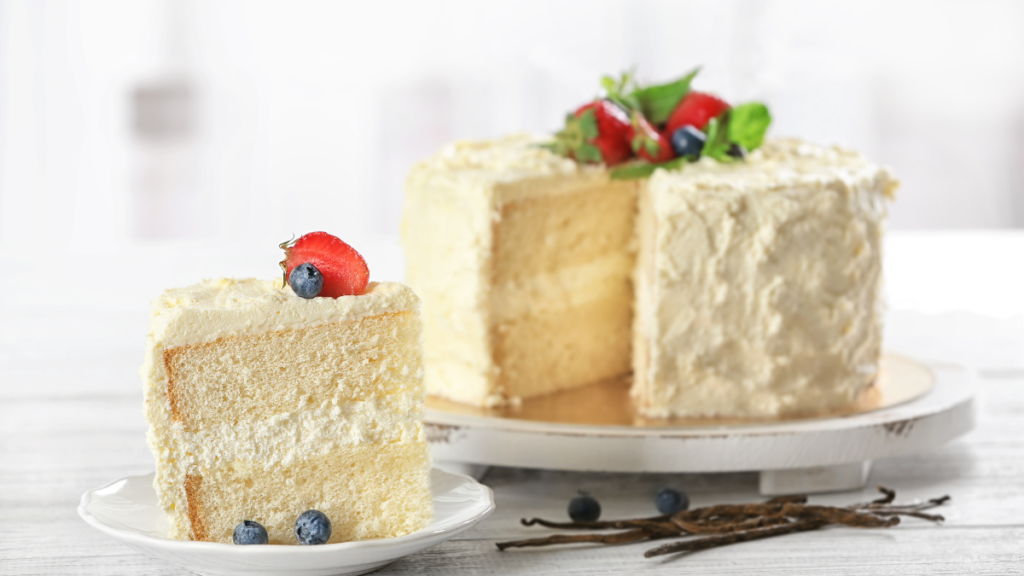
Assembling and Decorating:
- Level the Cakes: If needed, use a serrated knife to level the tops of the cakes to create an even surface.
- Layering and Frosting: Place one cake layer on a serving plate. Spread a layer of your favorite frosting—buttercream, cream cheese, or whipped ganache—over the top. Carefully place the second cake layer on top.
- Crumb Coat: Apply a thin layer of frosting all over the cake to seal in crumbs. Chill for about 20 minutes.
- Final Frosting: Apply a generous layer of frosting to the entire cake. Use an offset spatula to create smooth sides and a beautifully swirled top.
Troubleshooting and Flavor Variations:
- Troubleshooting: If your cake sinks in the middle, it might be due to overmixing the batter. Also, ensure your leavening agents are fresh.
- Flavor Variations: Infuse the cake batter with citrus zest, fold in chocolate chips, or add a teaspoon of your favorite extract for unique flavor twists.
Notes and Tips:
- Room Temperature Ingredients: Using room temperature eggs, butter, and milk ensures a smoother batter and even baking.
- Measuring Flour: Spoon the flour into your measuring cup and level with a knife to avoid compacting it.
Best Vanilla Cake Ever
Equipment
- 2 9-inch round cake pans
- Parchment paper
- Mixing bowls
- Electric mixer
- Wire rack
Ingredients
- 2½ cups cake flour
- 1¼ cups sugar
- 2½ tsp baking powder
- ½ tsp salt
- 1¼ cups unsalted butter soften
- 1½ cups sugar
- 4 large eggs room temperature
- 1 tbsp pure vanilla extract
- 1 cup whole milk warmed
- ½ cup vegetable oil
Instructions
- Preheat your oven to 355°F (180°C). Grease the cake pans, line the bottoms with parchment paper, and grease again.
- In a bowl, whisk together the flour, baking powder, and salt. Set aside.
- In another bowl, cream the softened butter and granulated sugar until pale and fluffy. Use an electric mixer for best results.
- In another bowl, cream the softened butter and granulated sugar until pale and fluffy. Use an electric mixer for best results.
- Gradually add the dry flour mixture and the milk to the butter mixture, beginning and ending with the flour. Mix on low speed until just combined.
- Divide the batter evenly between the prepared pans. Smooth the tops with a spatula. Bake for 25-30 minutes, or until a toothpick inserted into the center comes out clean.
- Let the cakes cool in the pans for 10 minutes, then turn them out onto wire racks to cool completely.
Notes
- Room Temperature Ingredients: Using room temperature eggs, butter, and milk ensures a smoother batter and even baking.
- Measuring Flour: Spoon the flour into your measuring cup and level with a knife to avoid compacting it.
As you slice into this tender vanilla cake, let its simplicity transport you to moments of joy and nostalgia. Now, it’s your turn to create memories—share your baking journey with us! Tag @kealicious_bakery and let the world admire your masterpiece. Ready to embark on your baking adventure? Let’s get started and celebrate the sweetest moments together!
